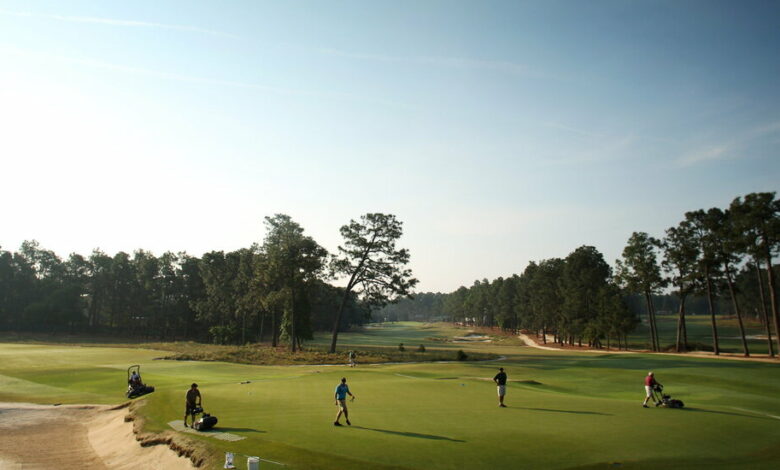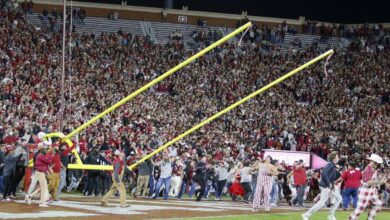A masterpiece in Pinehurst once again hosts the US Open

Golf is a game where chance and chance can lift or deflate even the most experienced players. Those at this week’s U.S. Open on Course No. 2 at Pinehurst Resort & Country Club are sure to get good and bad breaks in the native areas outside the fairways; the same goes for the bounces their balls make around the greens.
But chance played a big part in architect Donald Ross’s creation of the course, which in 2020 became the United States Golf Association’s first anchor venue for the U.S. Open. (That means the club hosts the national championship every five years.)
In 1899, Ross worked at the Royal Dornoch Golf Club in Scotland, wrote Lee Pace, the author of “The Golden Age of Pinehurst: The Story of the Rebirth of No. 2.” After hearing a Boston golfer talk about how quickly golf was growing in the United States, Ross and another club employee decided they both wanted to go to America. But someone had to stay in Dornoch to keep that club going.
So the two friends thought there was only one fair way to decide who would go to America and who would stay in Scotland: a coin toss.
Ross won the flip and emigrated, arriving in Boston. There he began working at a local golf course near the home of James Tufts, the founder of Pinehurst Resort & Country Club. In 1900, Tufts hired Ross to work at Pinehurst in the winter when the Massachusetts course would be closed. That chance assignment began Ross’s love for the North Carolina sandhills, which he said reminded him of his home in Dornoch.
By the time of Ross’s death in 1948, he had designed approximately 400 courses in the United States and had become one of the world’s best-known course architects.
Ross’s standing in the sport has been validated by the number of championships contested on his courses. Of the past 1,000 USGA championships, 175 have been played on Ross designs, said John Bodenhamer, chief championship officer for the United States Golf Association and the person charged with designing this year’s Open at Pinehurst. That’s more than any other architect.
Ross courses, such as Aronimink, Oakland Hills and Oak Hills, have also hosted the PGA Championship, another major golf course. (The first PGA Championship was played in 1916 at Siwanoy Country Club in New York, designed by Ross.) Each year its courses host regular PGA Tour events, such as the Tour Championship at East Lake Golf Club in Atlanta, which ends the season.
Yet of all the courses designed by such a prolific and beloved architect as Ross, Pinehurst No. 2 is considered by many in the sport to be the best.
“This was his masterpiece, his Mona Lisa,” Bodenhamer said. “He felt like he could do things here that he couldn’t do elsewhere.”
If chance brought Ross to Pinehurst, a connection to the land — specifically the sandy soil that is ideal for golf course development and reminded him of the links of Dornoch — kept him there. His house was next to the third Pinehurst No. 2 and he decided to make the track his design laboratory.
“He knew the best land for golf was sand on the water, but if you can’t be on the water, it’s still on sand,” said Vaughn Halyard, president of the Donald Ross Society“It’s the drainage, the tight lighting, the consistent playing conditions that sandy ground provides. Ross came back and said, ‘This is where I have the infrastructure, the people, the city, the country, so I’m going to focus on No. 2 ; this is where I’m going to anchor my wave design.'”
At Pinehurst, Nos. 1, 3 and 5 are Ross designs, as was No. 4 until Gil Hanse remade it in 2018. Ross roamed the sandhills region, building courses like Southern Pines, Mid Pines and Pine Needles that stand today.
“Pinehurst was the foundation for Ross’s creativity, but he experimented all over the place,” Halyard said. “He would put a feature or a hazard exactly where it would make it harder for the better player. But the average player didn’t encounter that hazard unless he made a big mistake.”
Ross also benefited from the Tufts family letting him tinker with the course as he saw fit. In 1935, he changed the greens from sand to grass, a risk considering that hardier northern grasses and heat-loving southern grasses were both struggling in the Carolinas. He also replaced two holes he had previously constructed with two new ones that changed the route of the course. (Holes 4 and 5 were added to No. 2, from an employee course that had been on the property. Today, Pace said 1, 2 and 11 through 18 are Ross’s original 1907 design.)
But this constant tinkering drew attention to the region.
“The Tufts family discovered early on that one way to generate publicity was to organize major competitions that attracted people from all over the country,” Pace said. “The North and South Amateur and the North and South Open were designed to bring them in in the early 20th century. They attracted the best players from all over the country: Francis Ouimet, Tommy Armor, Gene Sarazen. They liked the course and talked about it when they went home.”
Their approval gave Ross even more freedom to tinker, and that earned him the respect of his contemporaries.
“Without a doubt, Ross considers this his greatest achievement, which says a lot,” said AW Tillinghast, who designed Winged Foot and Baltusrol, other courses that have housed several majors, after visiting Ross in 1935. “Every touch is Donald’s himself, and I doubt whether a single outline was formed unless he stood there with a critical eye.
“As we stood hole after hole, the great architect proudly drew my attention to every subtle feature, convinced that my appreciation of his artistry must be greater than that of a less trained eye,” he added. “Nothing escaped me and after our round together I told him with all honesty that his course was beautiful, without one weakness, and one that rivals the truly great courses in the world today.”
This week is the fourth US Open that Pinehurst organizes. The course, Bodenhamer said, is 40 feet shorter than when the Open was last held in 2014, a rarity in a game where the courses get longer every year. Distance has never been something that crushed competitors; it was the greens that were the reason Ross’s No. 2 didn’t host an Open until 1999. Innovations in agronomy were needed to catch up with Ross’s designs so that the greens could be cut short enough to achieve the desired speed for a while. National Championship.
Before Pinehurst’s third US Open in 2014, the ownership group brought in Bill Coore and Ben Crenshaw to strip away all the changes made after Ross’ death. Bodenhamer said the designers were looking for the USGA’s promise that the organization would allow the course to be played as Ross intended: wild and open, without the narrow corridors and high rough terrain that were common in the 1990s and 2000 had been an important part of the US Open.
“We said we wouldn’t do that,” Bodenhamer said. “We’re going to play it the way Mr. Ross intended. It’s going to be solid and fast. It’s going to bounce.”
And under those circumstances, the mix of skill and chance that led to the creation of No. 2 will be on display as the world’s best players compete to create Ross’s masterpiece.




